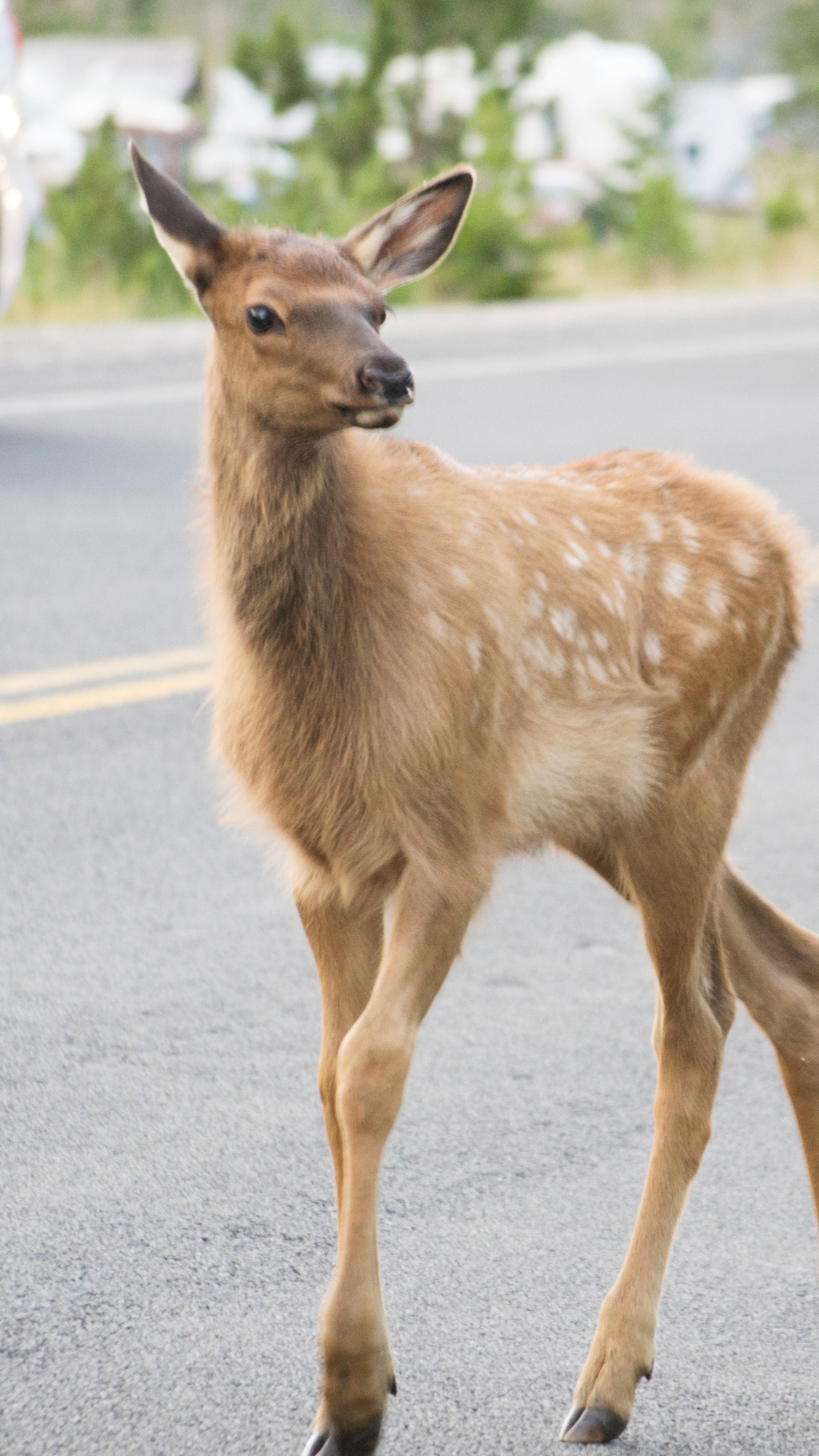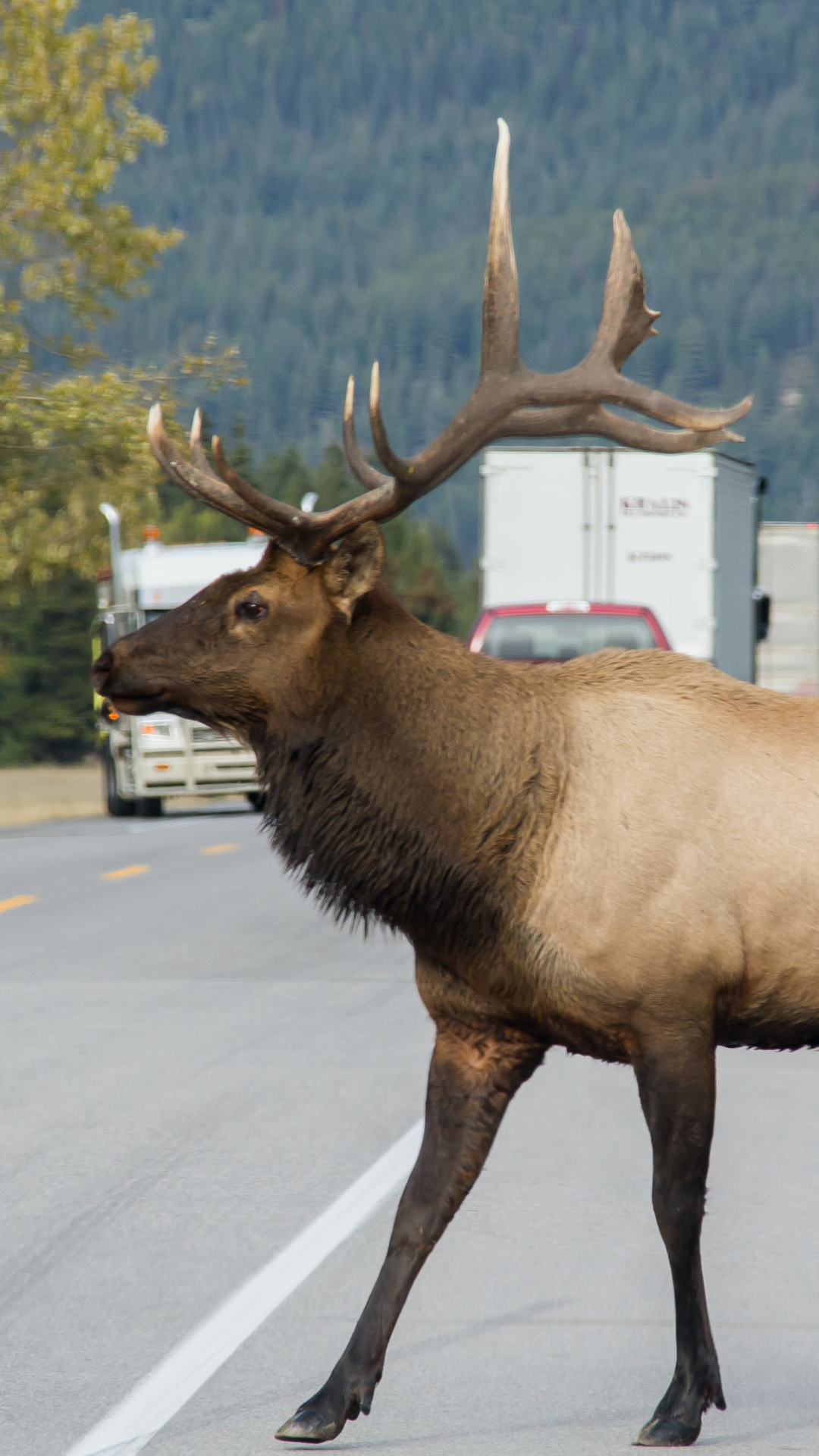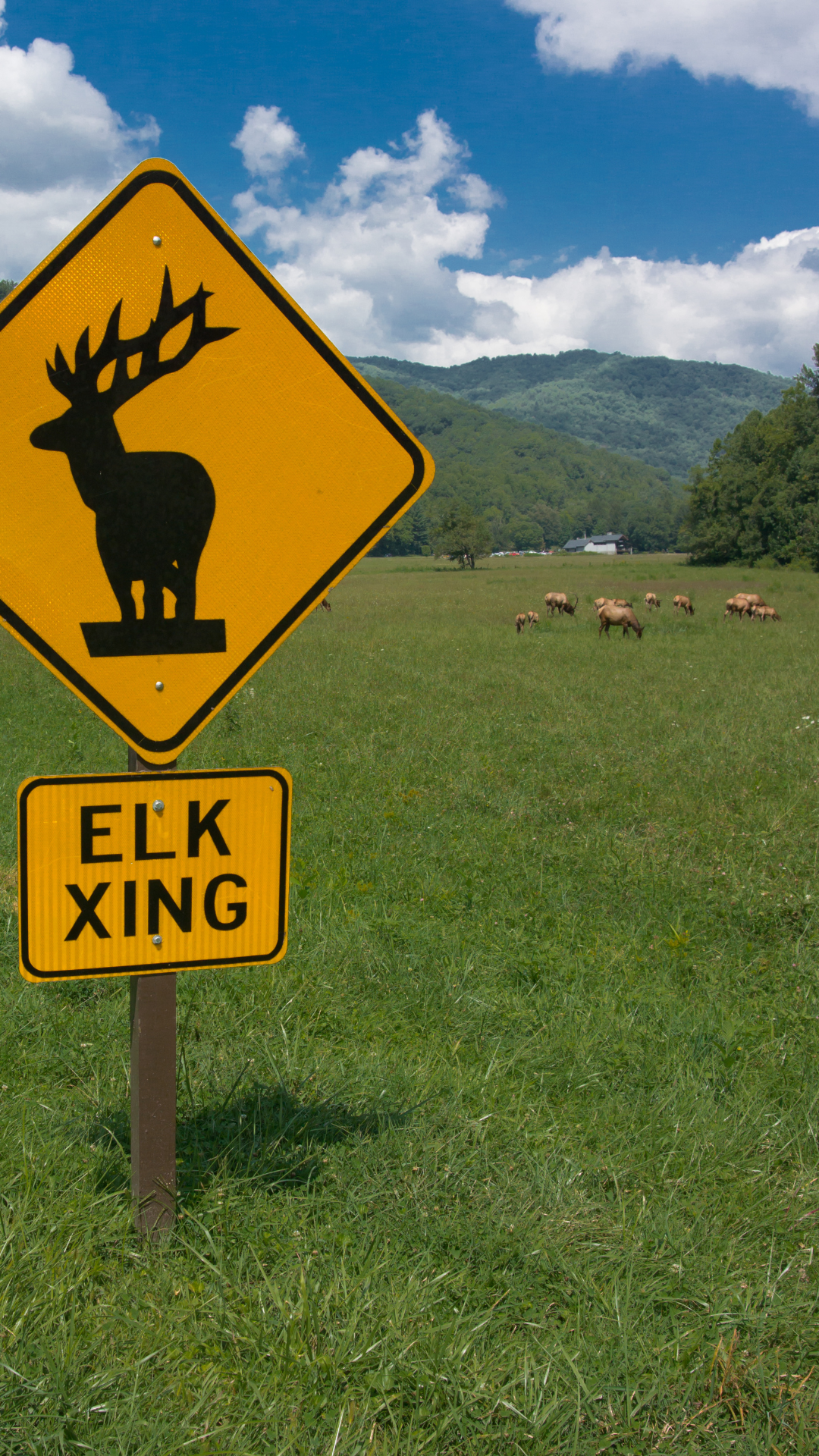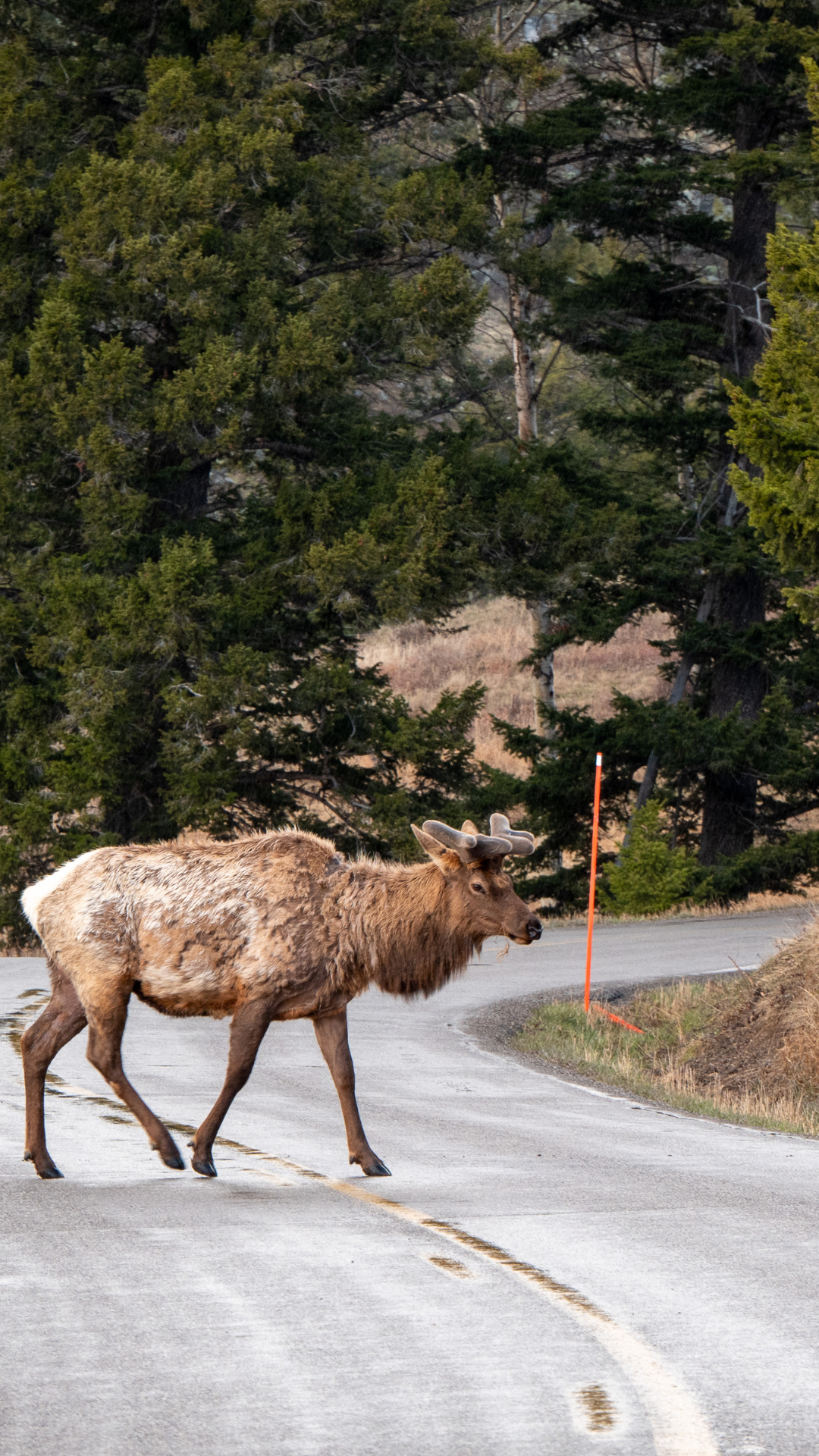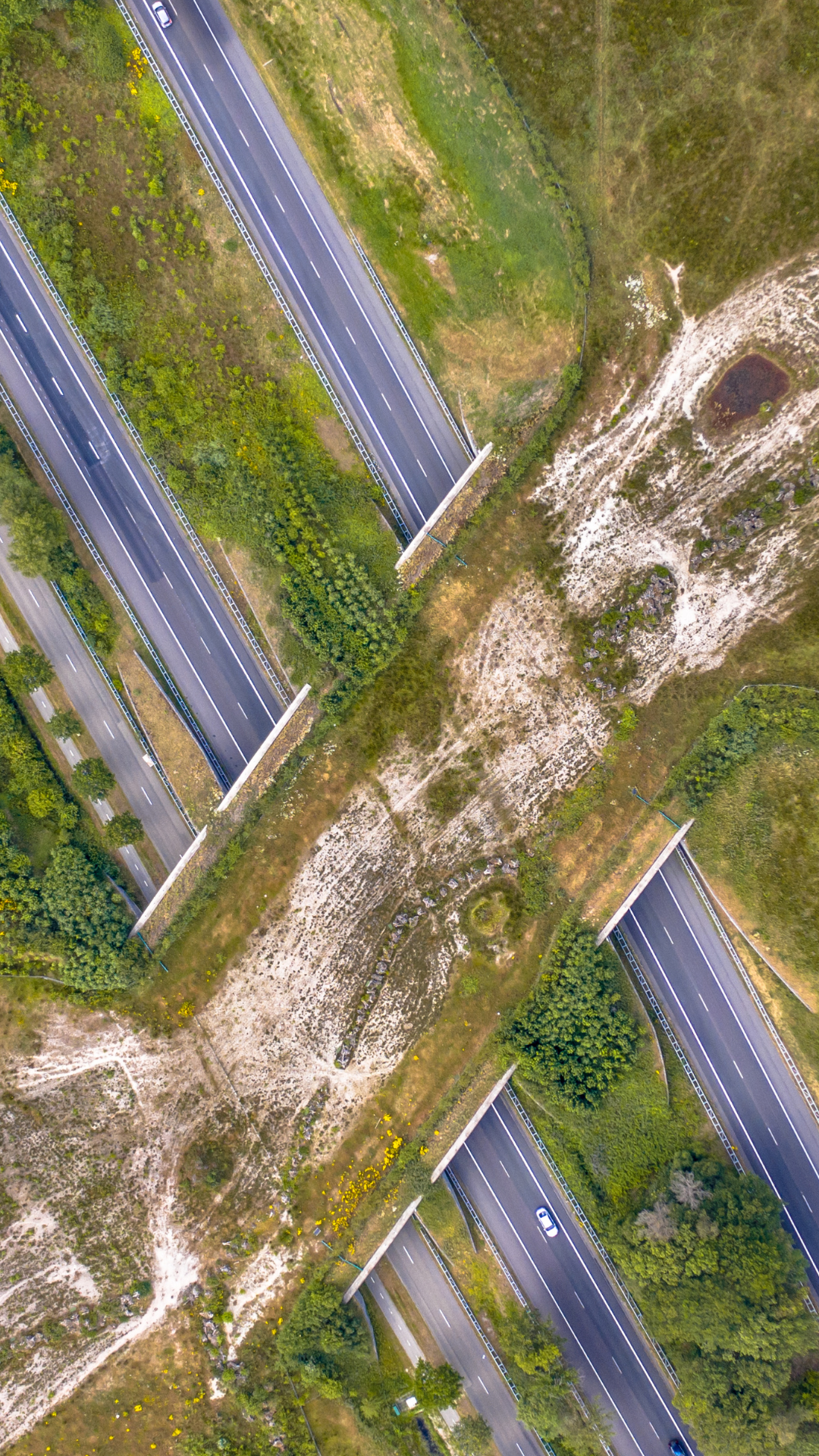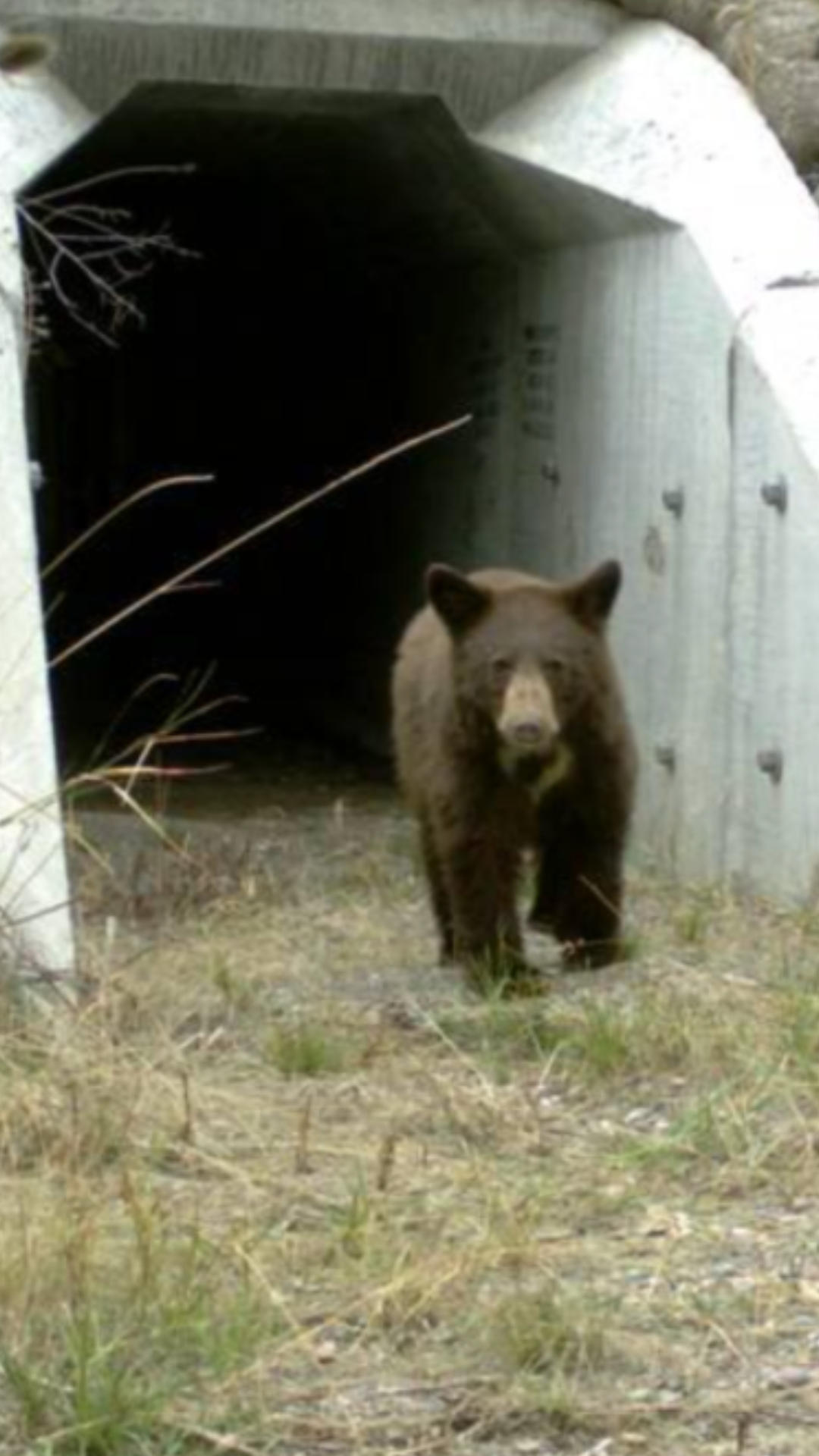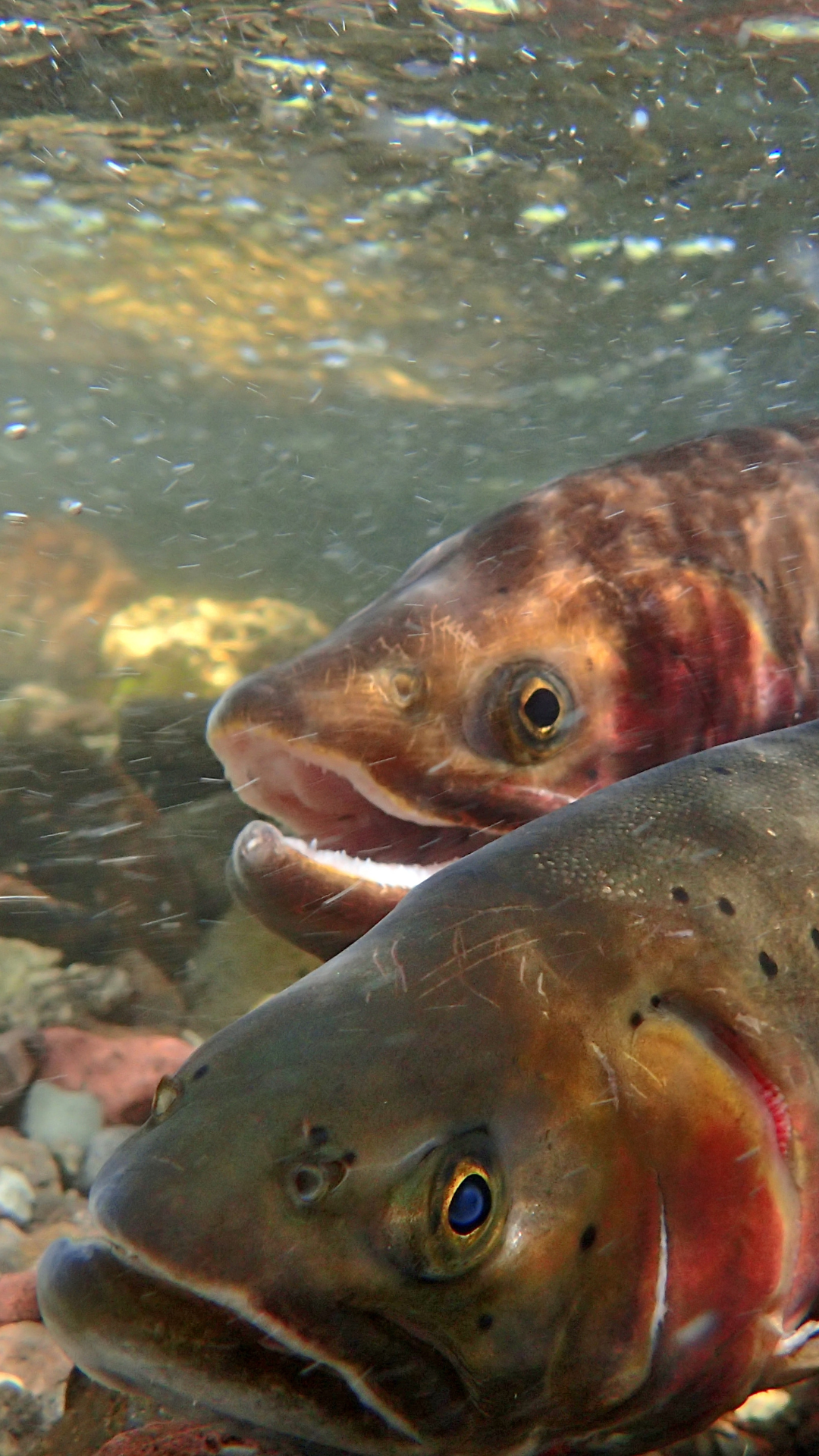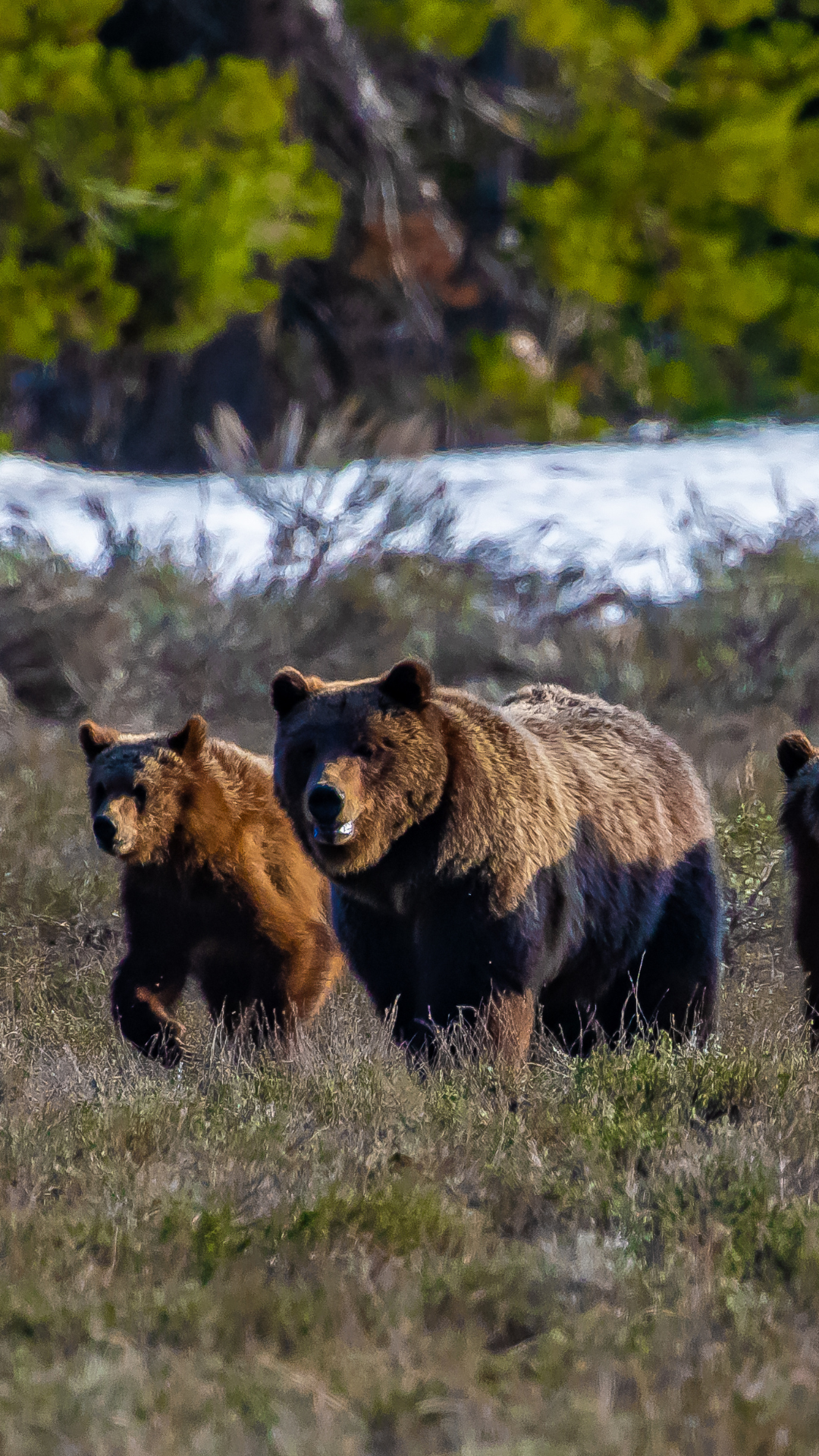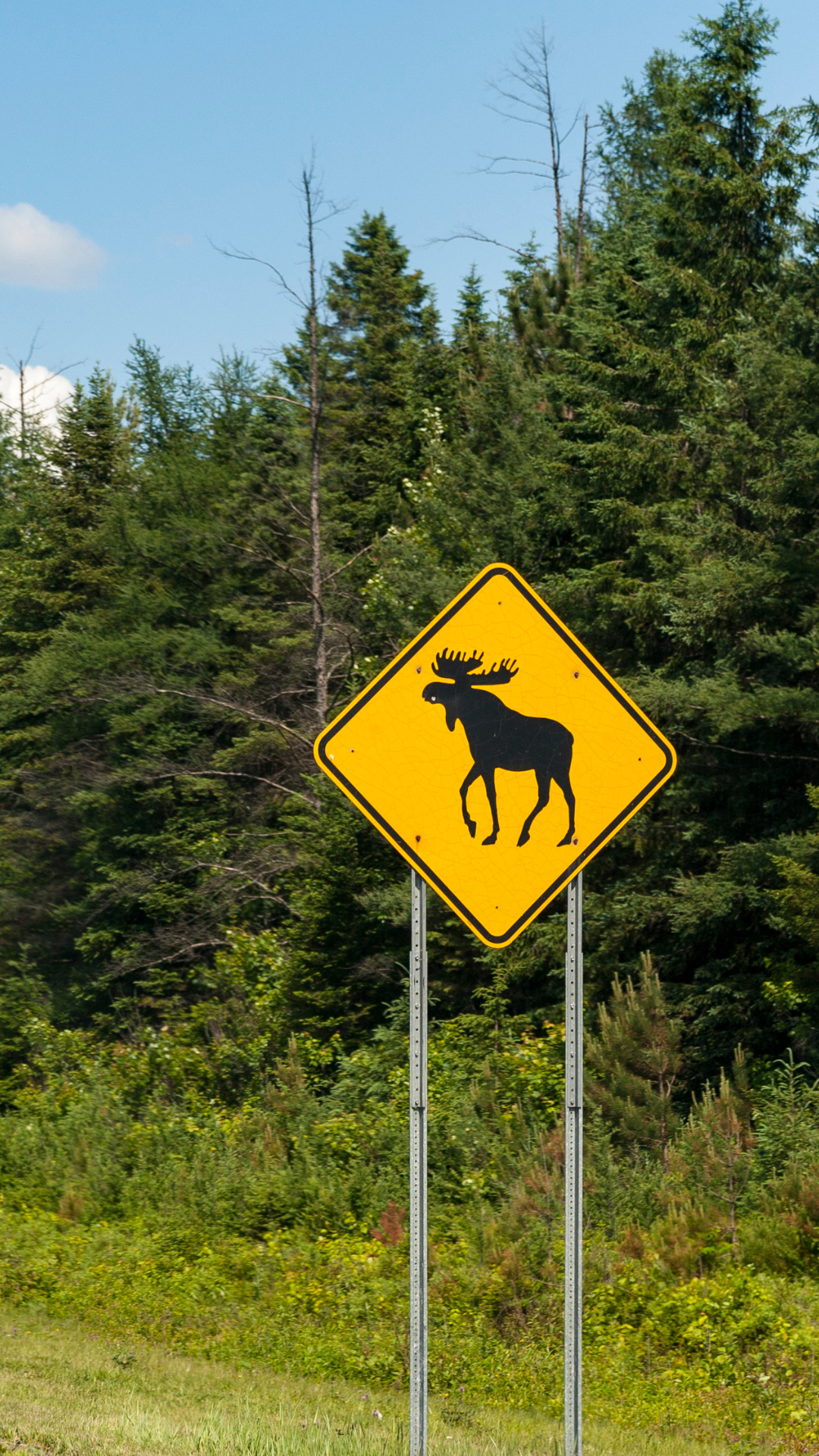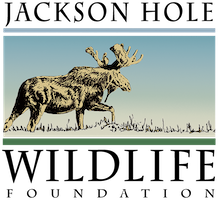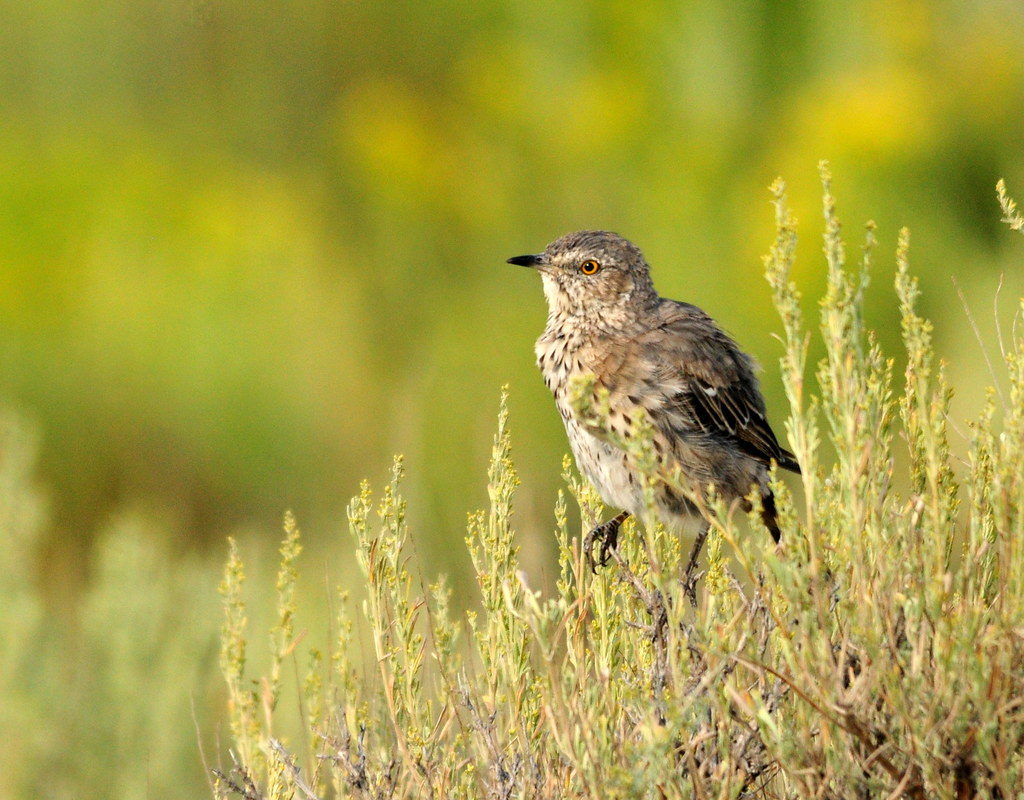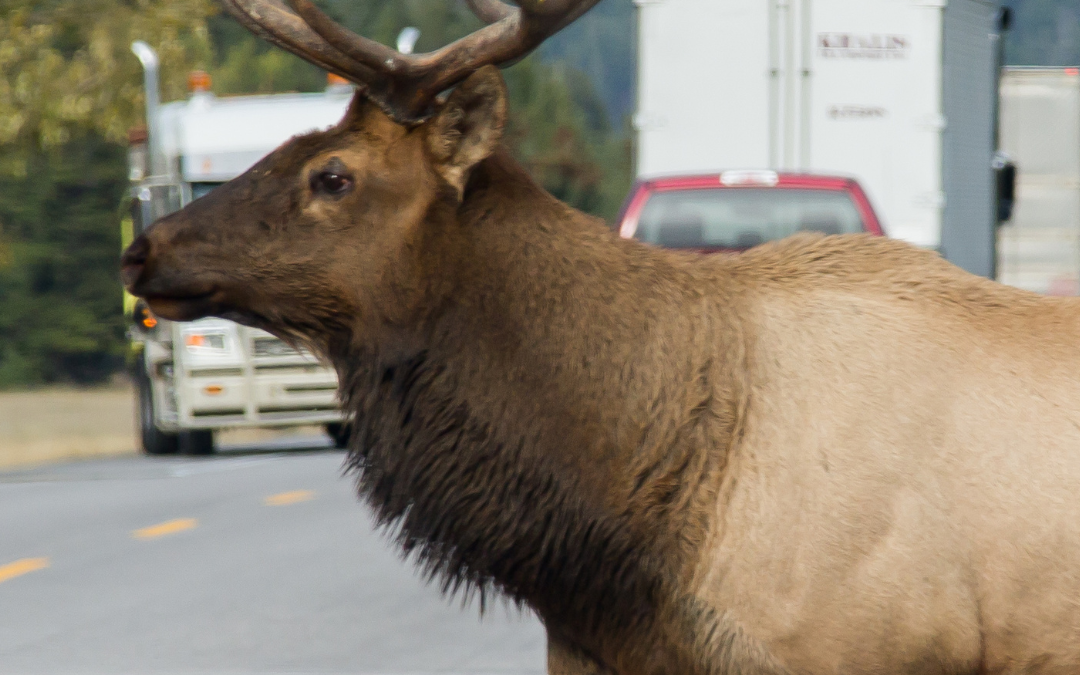
by jhwildlife | Dec 23, 2024 | Blog, Give Wildlife a Brake, Jackson Hole Wildlife Foundation, Nature Mapping Jackson Hole
do not look both ways before crossing the road
Thousands of elk migrate from the higher elevations of Grand Teton National Park and surrounding areas to lower valleys, seeking food and shelter each winter. This seasonal journey is essential for the survival of the elk herd, but it also brings them into direct conflict with human infrastructure—most notably, busy roads like North Highway 89.
The National Elk Refuge, established in 1912, provides critical winter habitat for the Jackson Elk Herd, which can number as many as 11,000 animals. However, as elk move toward the refuge, they frequently cross North Highway 89, a major route connecting Jackson to the park.
These crossings often occur at dawn and dusk, when visibility is limited, increasing the risk of vehicle collisions. This time of year, elk are on the road in larger numbers, and Jackson Hole Wildlife Foundation, with partners Wyoming Game and Fish and Teton County, has reported a rise in roadkill incidents along this corridor.
The Challenge on North Highway 89
North Highway 89 sees heavy traffic year-round, and during elk migration, it becomes a hazardous bottleneck for wildlife. Data collected by JHWF, Wyoming Game and Fish Department, and Wyoming Department of Transportation shows that wildlife-vehicle collisions are a significant cause of mortality for elk, moose, and deer in the region. For drivers, an unexpected collision with a 600-pound elk can cause severe damage, injuries, or fatalities. Human safety and wildlife preservation are intertwined, making solutions to this challenge a community priority.
Proposed Wildlife Crossings
To address the growing problem, Teton County, Wyoming has proposed wildlife crossings and funnel fence at high-risk areas in Teton County, including:
North Highway 89: 3 Crossings (1 Overpass, 2 Underpasses)
- Wildlife Overpass: This structure allows animals to cross above the road on a vegetated bridge, mimicking their natural habitat. Overpasses are particularly effective for larger mammals like elk and pronghorn that prefer open spaces.
- Wildlife Underpasses (2): These tunnels provide safe passage beneath the road, offering an effective solution for animals that prefer cover.
- Funnel Fence: (4 miles) Guided by funnel fencing, the underpasses and overpasses encourage wildlife to avoid the roadway entirely, reducing collision risks.
Teton Pass: 1 Overpass, 3 Underpasses, and a Fish Passage
- Wildlife Overpass: Similar to the North Highway 89 overpass, this structure will reconnect migration routes over the highway, reducing risks for both wildlife and drivers.
- Wildlife Underpasses (3): These underpasses will provide multiple safe routes beneath the Teton Pass Highway for animals such as deer, moose, and smaller mammals.
- Fish Passage: A specialized structure allowing aquatic species to move freely along their natural waterways without obstruction from road infrastructure. This supports fish populations and improves the overall health of the ecosystem.
- Funnel Fence: (4 miles) Guided by funnel fencing, the underpasses and overpasses encourage wildlife to avoid the roadway entirely, reducing collision risks.
Camp Creek: 3 Underpasses and 1 Overpass
- Wildlife Overpass: As with the other overpasses, this vegetated bridge provides a natural, open pathway for wildlife like elk, facilitating their migration while keeping them off the road.
- Wildlife Underpasses (3): These crossings will guide animals safely below the road, preventing wildlife-vehicle collisions and maintaining connectivity across the landscape.
- Funnel Fence: (5.5 miles) Guided by funnel fencing, the underpasses and overpasses encourage wildlife to avoid the roadway entirely, reducing collision risks.
Wildlife crossings, including overpasses and underpasses with funnel fences, are proven to reduce collisions and support healthy migration. A study of similar projects on US Highway 191 near Pinedale, Wyoming, found a 90% reduction in wildlife-vehicle collisions after implementing overpasses and underpasses. This project, monitored by the Wyoming Department of Transportation (WYDOT) and other agencies, highlights the effectiveness of combining crossings with fencing to guide wildlife safely above or below roadways. The Trappers Point crossing has become a national model for mitigating migration conflicts.
Scientists emphasize the importance of open migration corridors for ungulates. Fragmented or blocked movement routes can force wildlife into smaller, less suitable habitats, leading to stress, reduced herd sizes, malnutrition, and disrupted ecosystems. By building crossings, we reconnect critical wildlife movement routes and reduce risks for drivers.
A High-Profile Fatality
The recent wildlife-vehicle collision death of Grizzly Bear 399, one of the most well-known bears in the Greater Yellowstone Ecosystem, highlights the devastating chain reaction caused by wildlife-vehicle collisions. Grizzly 399 and her cub were likely devouring an elk carcass in the Snake River Canyon that was very near to the section of the highway where she was killed. Roadkill draws predators like bears, wolves, and eagles to highways, dramatically increasing their risk of being struck by vehicles. Wildlife crossings can reduce these incidents by preventing collisions that leave carcasses on the roadside in the first place, breaking the cycle that endangers predators and scavengers.
While 399’s passing is a high-profile example of a wildlife-vehicle collision, the need for wildlife crossings extends far beyond any one species or one animal. Her death symbolizes the countless animals—ungulates, predators, birds, and smaller mammals—that lose their lives on roads each year.
Though 399 was internationally beloved and her story has drawn significant attention, she represents all wildlife navigating the dangers of high-traffic areas. We hope her legacy will inspire greater awareness and support for implementing wildlife-friendly crossing structures throughout Wyoming. These solutions have proven effective in reducing fatalities and reconnecting critical habitats, providing a safer future for all species that call this region home.
Give Wildlife a Brake and Nature Mapping: A Community Effort
The Give Wildlife a Brake program, led by JHWF, works to raise awareness and promote safer driving practices:
- Drive mindfully and observe the speed limit in key wildlife zones like North Highway 89, Teton Pass, and Camp Creek.
- Stay alert at dawn and dusk, when animals are most active.
- Observe wildlife warning signs that identify known crossing areas.
- Report collisions and roadkill to help scientists and officials prioritize safety improvements.
In addition, Nature Mapping Jackson Hole offers an easy way for community members to contribute to wildlife conservation. By becoming a certified Nature Mapper, participants can log wildlife and roadkill sightings using an app. The data collected is shared with Wyoming Game and Fish Department to better understand wildlife movements and identify problem areas. This citizen science initiative empowers residents to actively contribute to protecting the animals that define Jackson Hole.
Give Wildlife a Brake and Nature Mapping also work with local volunteers to monitor wildlife crossings, gather data, and educate residents and visitors about the importance of migration corridors.
Elk are an iconic part of the Jackson Hole ecosystem. They support a balanced food chain and play a key role in the region’s cultural and ecological identity. Their winter migration has occurred for centuries, long before roads and cars appeared in the valley. Protecting this natural behavior while improving public safety requires collaboration, science, and community effort.
While this blog focuses on elk migration, the need for wildlife crossings applies to all species in the Jackson region, including mule deer. There is no doubt that wildlife-vehicle collisions pose a significant threat, ranking as the third leading cause of bird fatalities each year. Drivers should remain vigilant, as animals crossing the road are often accompanied by others, including offspring or members of a herd, making caution essential for reducing collisions.
Review the Wildlife Vehicle Collision Report to learn more about the scope of this issue and the need for wildlife crossings as a proven solution. Support efforts to fund and implement wildlife crossings and participate in programs like Give Wildlife a Brake and Nature Mapping Jackson Hole to make Jackson Hole safer for wildlife and people.
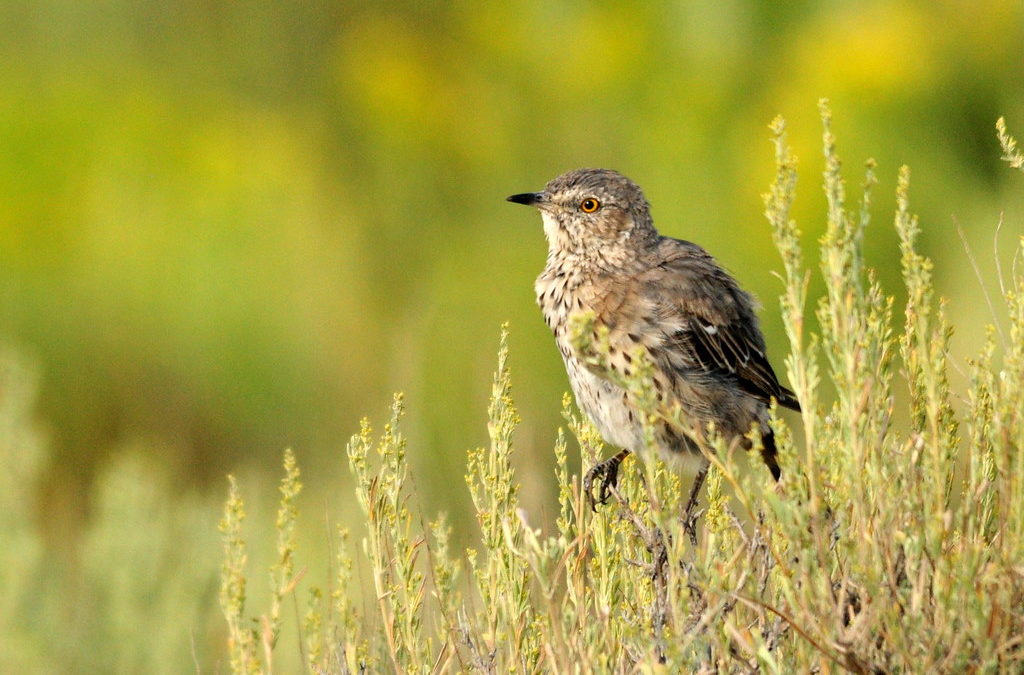
by jhwildlife | May 17, 2019 | Blog, Jackson Hole Wildlife Foundation
As the sun warms in mid-May, the aroma of sagebrush fills the valley once again. Sage-grouse leks are quieting down, bird migrants are staking out territories, and resident mammals are shifting their habitats. Nature mappers can see and hear a good number of species specialized to the sagebrush-steppe by taking a drive through the “flats” of Grand Teton National Park.
Many species depend upon the expansive sage-dominated habitat that covers much of the valley floor. Mountain Sagebrush is adapted to the well-drained glacial soils and provides shelter, food, and breeding sites. Greater Sage-grouse, Brewer’s Sparrow, and pronghorn require sagebrush and are deemed “obligates”. For others it is not essential but preferred habitat here in Jackson Hole. Savannah and Vesper Sparrows, Western Meadowlarks, Sage Thrashers, and Green-tailed Towhees build nests in the dense shrubs and search for insects and spiders for food. Red-tailed Hawks and Northern Harriers hunt for rodents, such as least chipmunks, Uinta ground squirrels, and voles. Hummingbirds zoom in to pollinate larkspurs and scarlet gilia.
The next few weeks is a great time to see and nature map wildlife. Songbirds are singing atop sagebrush to establish territories and attract mates. You may see males fly at intruders or observe courtship behaviors – bowing, feeding, and fluttering. Later on, most birds go quiet while raising chicks and so are much harder to find.
Mammals are also active. Pronghorn arrive just about now and soon will be giving birth. Coyotes will be looking for fawns hidden among the sage shrubs, although ground squirrels are much easier to catch. “Red” bison calves will be cavorting, and mule deer are moving about belching out volatiles of their favored forage: sagebrush. The smell of sagebrush leaves comes from terpenoids and coumarins, which serve as chemical defenses. Wildflowers begin blooming in abundance in June – paintbrush, hawksbeards, sulphur buckwheat, lupine, and balsamroot, adding to the splendor of the scene.
So take an early morning or evening drive through the park – around Antelope Flats, up the park road. Or better yet, find a spot to sit quietly with your binoculars and a spotting scope handy. And please, keep on nature mapping. We want to be sure our common sagebrush-steppe species stay common. Your observations help us know how these critters are faring over time.
Thank you!
Frances Clark, Nature Mapping Volunteer
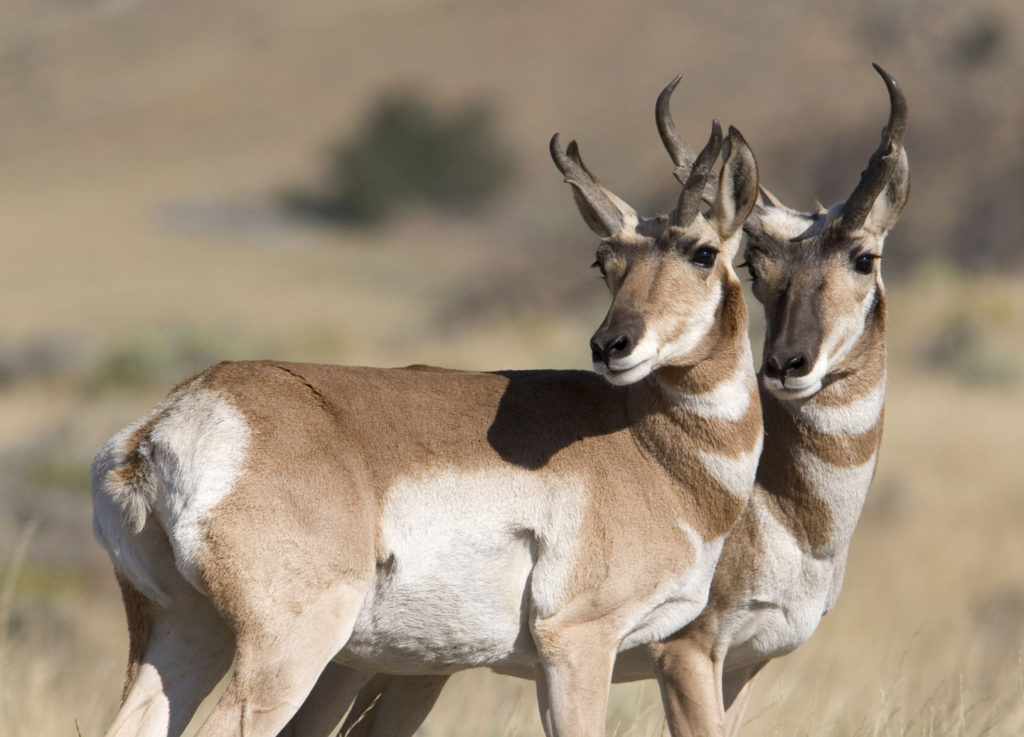
Pronghorn are an iconic species of the sagebrush-steppe. Photo: Mark Gocke.
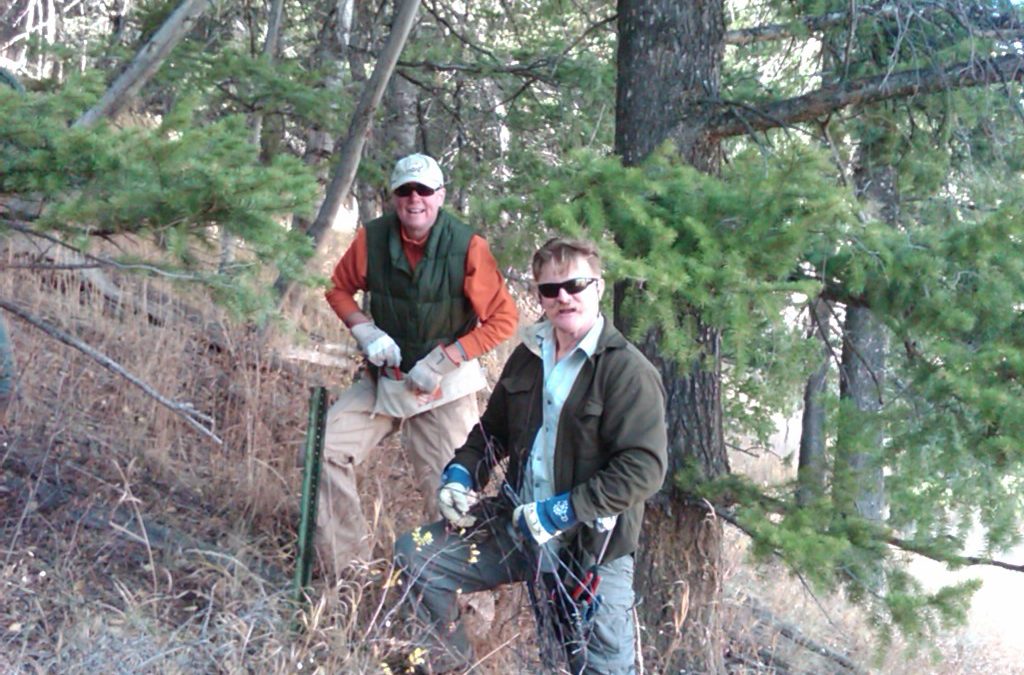
by jhwildlife | Aug 17, 2018 | Blog, Jackson Hole Wildlife Foundation, Wildlife Friendlier Landscapes
by Jon Mobeck, Executive Director
For 25 years, Jackson Hole Wildlife Foundation (JHWF) has worked to reduce human-caused impacts on wildlife. One of our most visible programs, Wildlife Friendlier Fencing, began in 1996 when a small group of local citizens and JHWF founders organized group fence pulls on Saturdays. Over the course of the next two decades, hundreds of individuals (almost entirely volunteers) helped to remove or modify almost 200 miles of fence. There have been so many key contributors that it would be unwieldy to list them all here, but we recognize two of them today for their dedicated efforts in the field, and for their legacies that inspire our work well after their lives were ended much too soon.
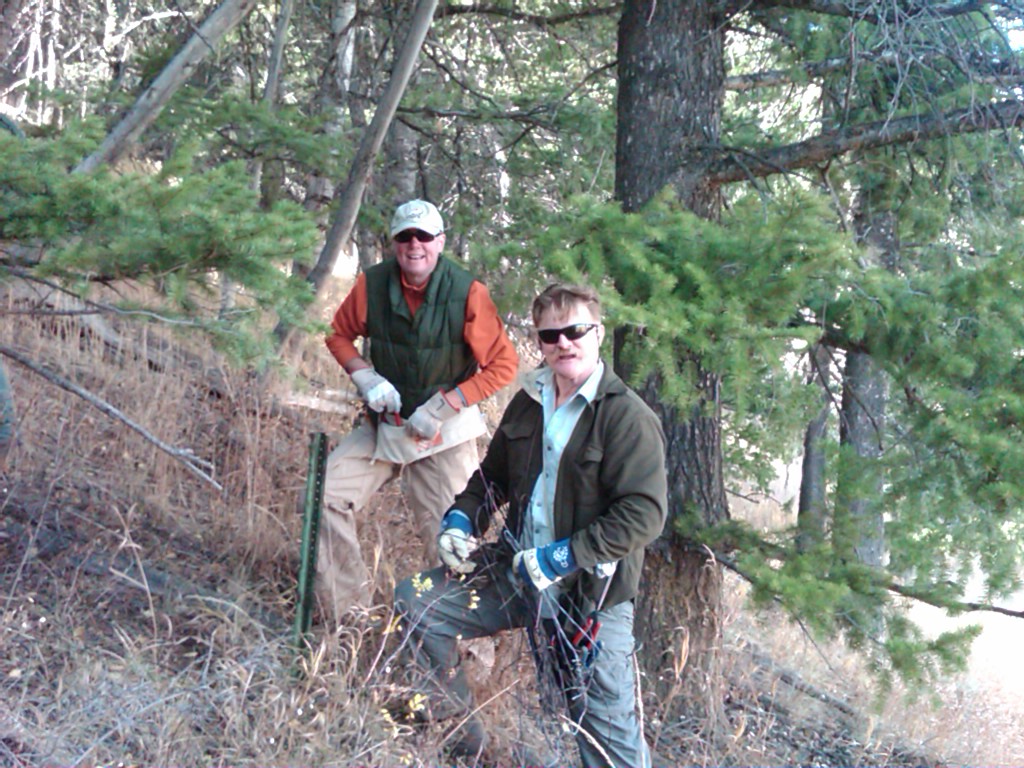
Sue Colligan (left) and Greg Griffith were invaluable contributors to the Wildlife Friendlier Fencing program for many years.
Sue Colligan was the Executive Director of the Jackson Hole Wildlife Foundation less than a decade ago, and all who remember her speak to her incredible dedication to the fence program. My personal recollection of Sue was as a member of an early incarnation of the Safe Wildlife Crossings for Jackson Hole group in 2011-2012. While I represented The Murie Center for that purpose, Sue advocated for wildlife on behalf of JHWF. At those meetings (in Vance Carruth’s living room), Sue used her voice effectively and with intelligent precision. I think she could say in 20 words what I convey in 100. Those who joined her on fence pulls have also spoken about her steady resolve to get things done for wildlife. When Sue’s illness took her life too soon, she left a legacy gift to JHWF to continue its essential work. With those funds, we have been able to purchase supplies for the Wildlife Friendlier Fencing program, and in 2018 we used funds left by Sue to purchase a work truck, which has been used extensively to support our Wildlife Friendlier Fencing program (it carries tools and gear to every project) and our Nature Mapping Jackson Hole program (it carries bird banding supplies, mist nets and gear to field sites weekly throughout the summer.)
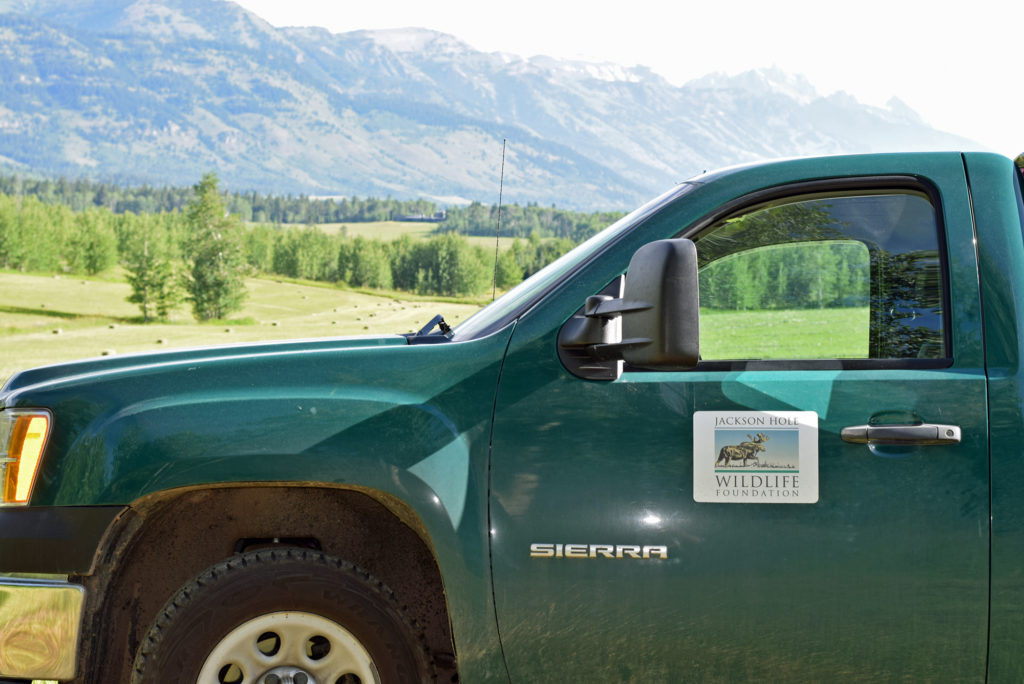
The Jackson Hole Wildlife Foundation truck sits ready for work at a Wildlife Friendlier Fencing project site in front of the Tetons.
Greg Griffith is known to many in Jackson as the unstoppable engine of the Wildlife Friendlier Fencing program for many years. A car accident took Greg from us very prematurely, but rarely a fence project goes by without someone mentioning Greg – his specific project methods, his concern for other volunteers, his fierce commitment to doing what is best for wildlife. Stories about Greg are now the stuff of legend, except there’s no indication that any of the stories are exaggerated, as many legends are. If someone says that he once carried six full rolls of barbed wire down a mountain and across a raging river, I’d have to believe it. It must have happened just that way. While I never met Greg, I feel that I know him through these stories, through the many volunteers who were deeply affected by him. When Greg passed, friends from far and wide made donations to JHWF in his honor. Now almost three years later, we still receive notes and occasional donations that reference Greg’s impact. He improved the lives of people as he made our valley better for wildlife. With the donations made in Greg’s name, JHWF purchased a cargo trailer to house all of our fencing tools and other JHWF field supplies. In the near future, we will place a graphic wrap on the trailer that promotes the program and the work of the many volunteers who have contributed to its success over the years.

JHWF Board President Aly Courtemanch delivers the new cargo trailer to the JHWF office.
There are many people to celebrate in the history of the Jackson Hole Wildlife Foundation, likely none of whom really care to be celebrated. Many have done the work quietly and doggedly, on Saturdays, in the heat, in the rain. Whatever it has taken to get the job done. The legacy that follows all of these individuals is one of humble service to the wild community, to which we belong. May it ever be so.
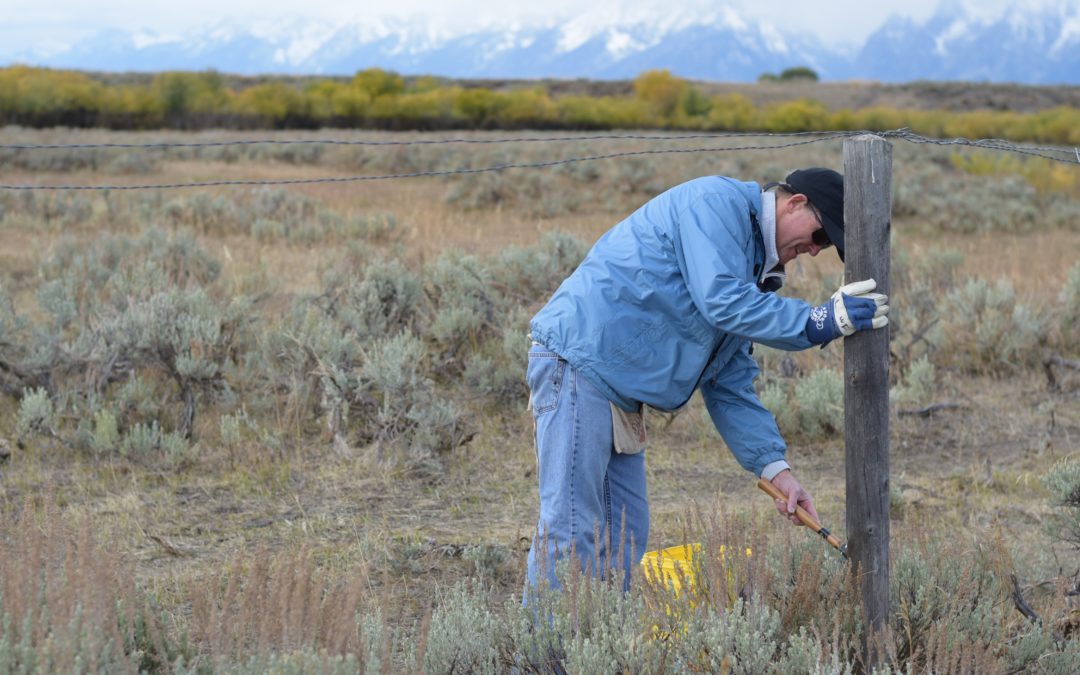
by jhwildlife | May 4, 2018 | Blog, Jackson Hole Wildlife Foundation
We are excited to welcome Bruce Pasfield to the Jackson Hole Wildlife Foundation’s (JHWF) Board of Directors executive committee as vice president and Ben Wise as a new board member.
Bruce Pasfield is an attorney who practices environmental law in Wyoming and Washington D.C. He is currently a partner in the law firm of Alston and Bird and has served on the JHWF board since October 2016. Residents of Jackson Hole since 2010, Bruce and his wife Nancy are certified Nature Mappers and frequently volunteer on fence projects. Bruce brings enthusiasm and natural curiosity about wildlife, as well as his legal skills, to his position on the executive committee. Bruce enjoys spending time with his wife and two grown children, mostly in the outdoors birding, cycling, climbing, hiking and skiing.
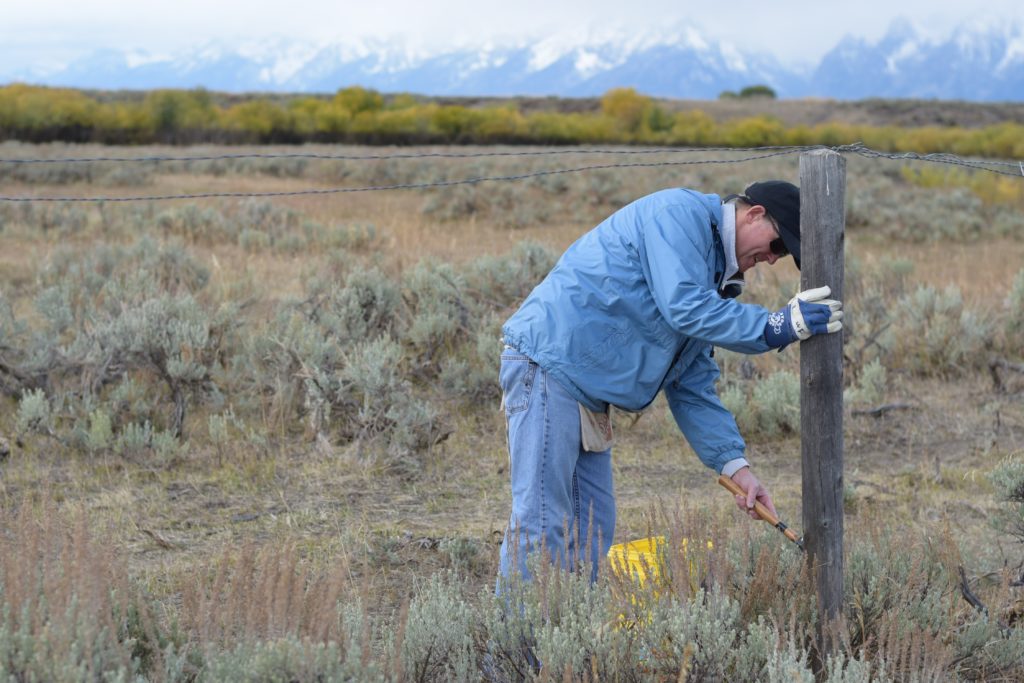
Bruce Pasfield helps on a fence project last fall on Public Lands Day.
A Worland, Wyo. native, Ben Wise has worked as the Brucellosis-Feedground-Habitat Biologist for the Wyoming Game & Fish Department in the Jackson Region since 2013. Ben is a key volunteer and strategist for the Wildlife Friendlier Fencing program. He also volunteers his time on the Scientific Advisory Committee (SAC) for Nature Mapping Jackson Hole, vetting observations and advising JHWF on scientific goals for the array of projects. In his free time, Ben enjoys traveling, hunting, fishing and exploring all that Wyoming has to offer.
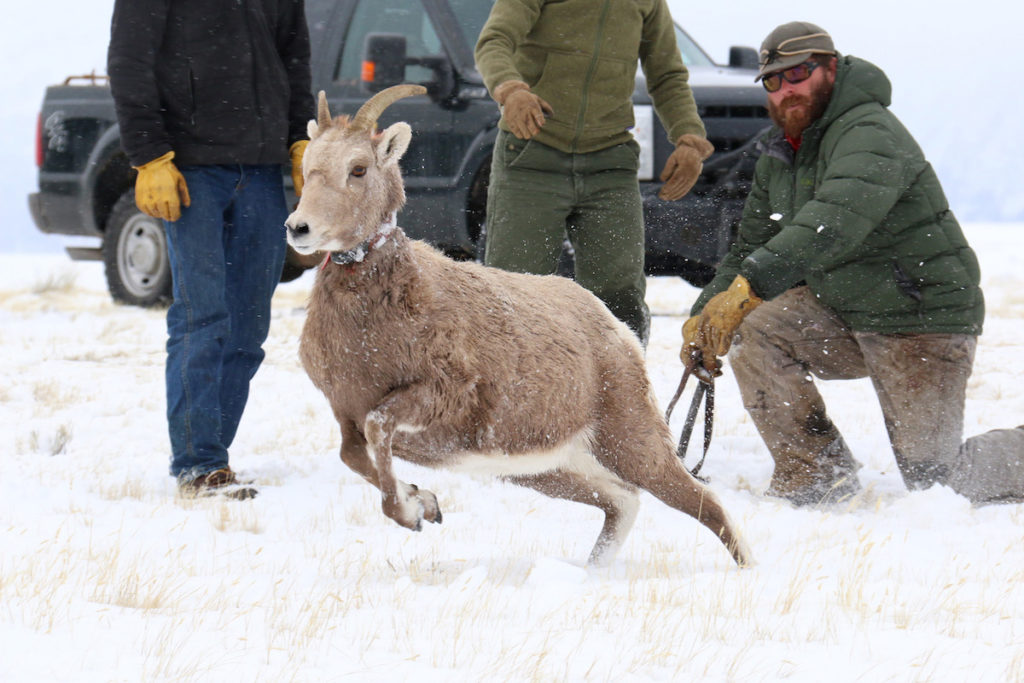
Ben Wise releases a bighorn sheep during a collaborative research project.
The JHWF Board of Directors is comprised of a diverse group of individuals with varied backgrounds including wildlife biology, wildlife management, public relations, law, conservation, planning and development, private business and local government.
The board represents a good cross-section of the community and enables us to have thoughtful debate about current issues and seize opportunities to advance meaningful on-the-ground work. Many board members contribute extensively as volunteers to increase our impact in our core program areas, extending a hands-on legacy that dates back to the origin of the organization in 1993.
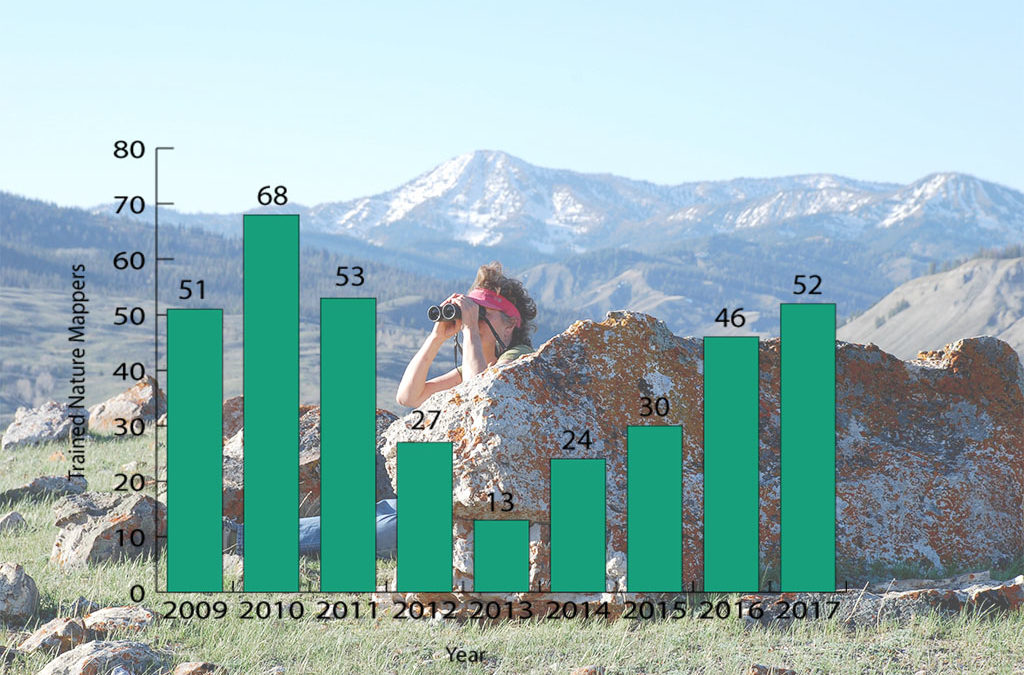
by jhwildlife | Dec 23, 2017 | Blog, Jackson Hole Wildlife Foundation, Nature Mapping Jackson Hole
Nine Years of Data: What are We Starting to Learn?
Over the past nine years, 464 people have been trained as certified Nature Mappers and have entered 47,829 observations into the Nature Mapping Jackson Hole program’s central database.
All this effort is filling wildlife observation and distribution needs not already covered by state and federal agencies or local research organizations. Furthermore, together we are fostering a community that looks deeper into the meanings of science and citizenship – therefore, realizing that to participate in the building of knowledge about how our world works, can have profound implications for the way we, Jackson Hole, relate to our natural environment and shape its future.
Thank you for getting involved in the experiences of seeing, feeling, and understanding nature in all its amazingness through Nature Mapping Jackson Hole.
Below is a current snapshot of our database (Note: numbers reflect entries made in the database as of December 7, 2017). In the coming year, JHWF will take a deeper look into the database to better understand data related to volunteer participation and to identify potential increases or declines in any species over time. Stay tuned, there is more to come!
2017 Observations by Project:
- Project Backyard – 2,611
- Casual Observations – 3,244
- Moose Day – 166
2017 Observations by Species:
- Reptiles and Amphibians – 71
- Birds – 3,806
- Mammals – 2,126

Figure 1. Total number of active Nature Mappers by year (2009-2017)
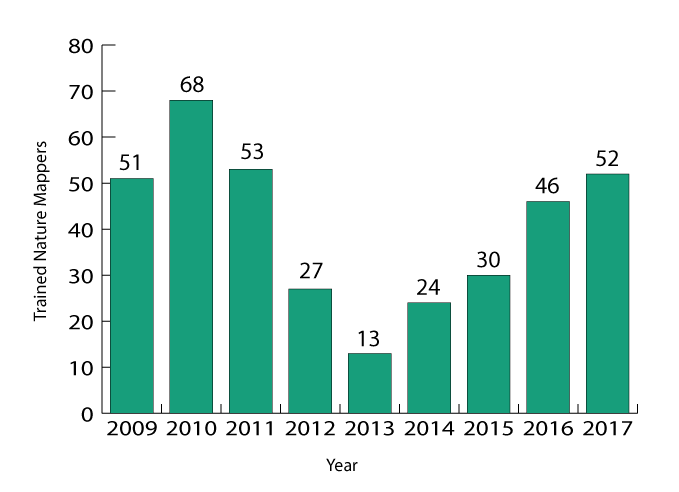
Figure 2. Number of newly trained Nature Mappers by year (2009-2017)
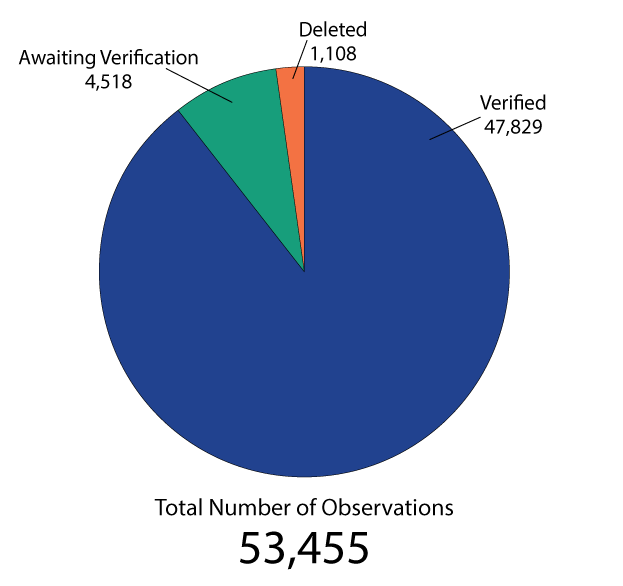
Figure 3. Total number of observations by status in the Nature Mapping Database
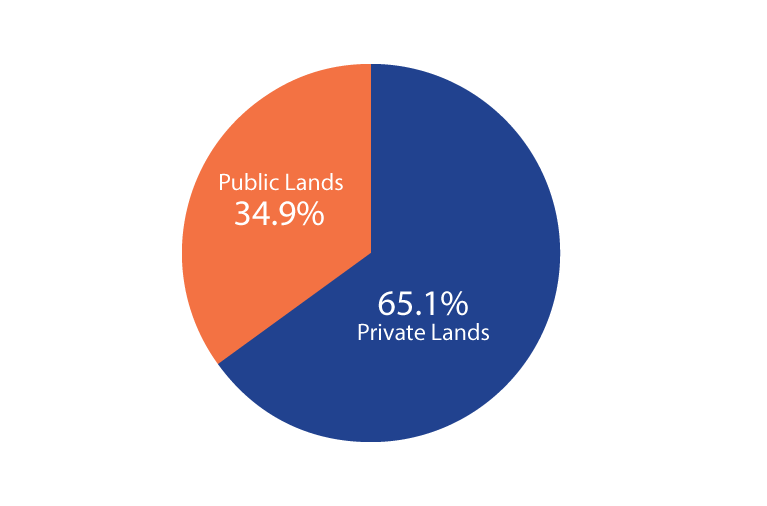
Figure 4. Percentage of Nature Mapping observations that are located on public vs. private lands (verified observations; 2009-2017)

Figure 5. Total number of species entered by Nature Mappers (includes verified, unverified and deleted observations; 2009-2017)
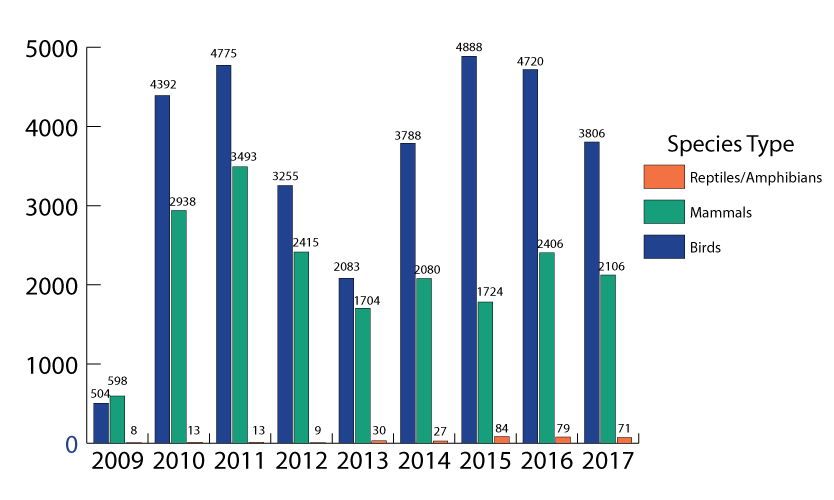
Figure 6. Total number of species by type entered by Nature Mappers (includes verified, unverified and deleted observations; 2009-2017)
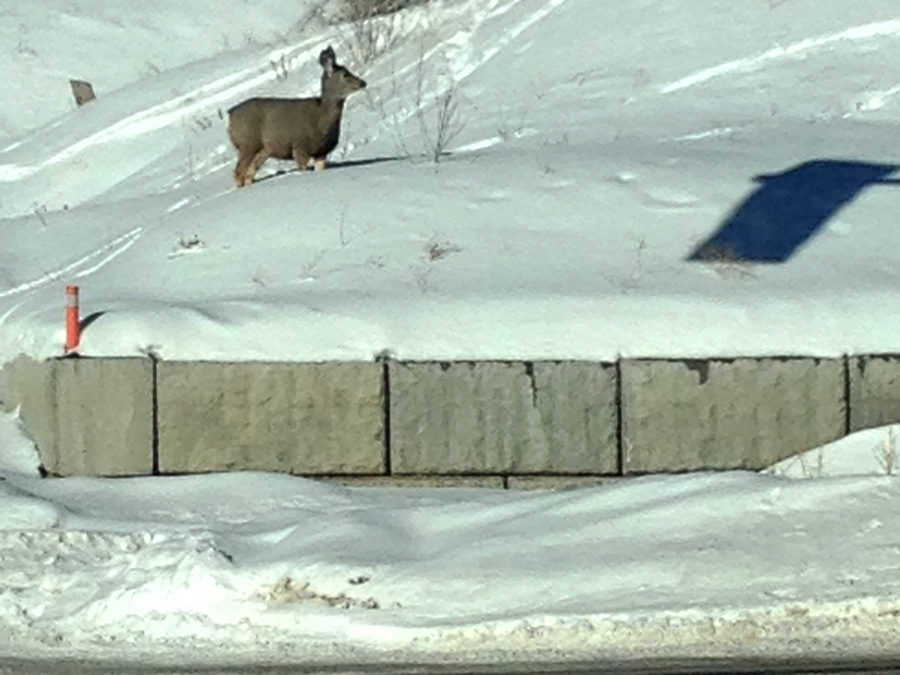
by jhwildlife | Apr 19, 2017 | Blog, Jackson Hole Wildlife Foundation, Uncategorized
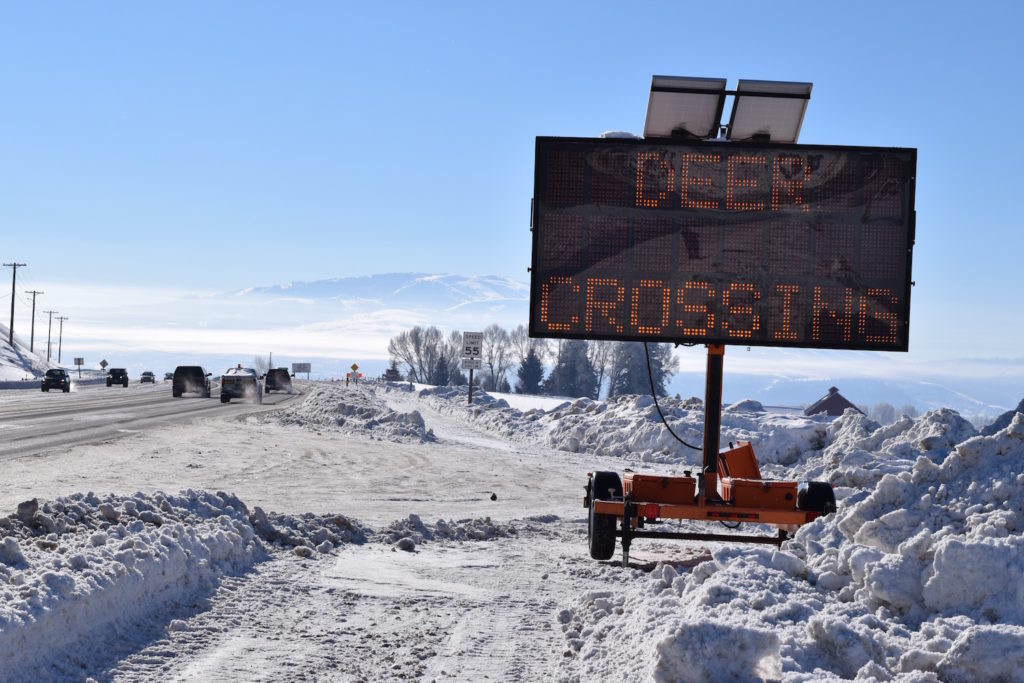
Dear friends of wildlife,
You can help the Wyoming Game & Fish Department (WGFD) and wildlife conservation groups better understand winter mortality of deer by participating in a half-day citizen survey on Saturday, April 29 from 8:30 a.m. – noon. WGFD will lead a carcass survey, along with representatives from Greater Yellowstone Coalition, Jackson Hole Wildlife Foundation, and the Jackson Hole Conservation Alliance, which will include the South Highway 89 corridor from Hoback Junction to the Jackson town limit.
We all know that this past winter has been a bad one for our wildlife. The data we collect will contribute to WGFD and conservation groups management of these wildlife herds. No experience in carcass surveying is needed! Agency professionals from WGFD will show you what to look for and how to conduct routine but important assessments.
We’ll meet at 8:30 a.m. at the Hoback Junction carpool lot near Hoback Market, discuss the day’s plan, the science underlying the survey, and volunteer roles while enjoying donuts and coffee. We’ll do our survey and return around noon. Some folks may gather for lunch thereafter.
Learn about and participate in wildlife science!
Volunteers are encouraged to take part in carcass assessments by extracting teeth and assessing bones with guidance from wildlife professionals. Please bring a stout knife and/or a saw if you’d like to participate in this aspect of the survey.
We will provide: Safety vests, data sheets, rubber gloves for handling carcasses (optional), packets for tooth samples, donuts and coffee, fun!
Volunteer notes
Please dress warm, appropriate for the conditions with boots, layers, sunscreen, etc. and bring a water bottle any other personal essentials in a small backpack.
Each volunteer is free to contribute for as long as they like, covering as much ground as is comfortable. We will break into teams assigned to various sections of different sizes to accommodate everyone. Volunteers will survey land within the highway’s right of way – generally well marked by a fence, but we’ll provide instruction on minimizing any safety risks.
Carpooling is encouraged, so if you do not have transportation or would prefer not to drive, we would still love to have you join us!
If you’d like to join us in this scientific survey, please email Jon Mobeck at jon@jhwildlife.org by Tuesday, April 25 so we can assign territories prior to the survey day.
We look forward to seeing you on April 29!

